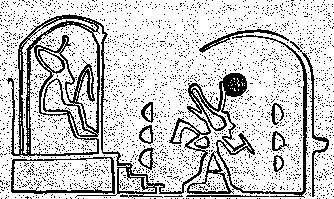To simplify we can reorganize the 12-glyph structure into a structure with only 8 glyphs:
The complex *Ca14-21 has an empty space in the center, similar to that in e.g. Eb6-1:
Only 2 mata are drawn in *Ca14-21, and they are at left. But at top right the next mata is on its way. The empty space in the middle probably indicates winter solstice, the time when the fire is extinguished. But at right (in front) lies the fire of the new year. The symbology is quite as in ancient Egypt with Pharaoh temporally being invisible because he has entered the sanctuary of the wolf-god (Upwaut, the 'Opener of the Way'):
. The 2 mata in *Ca14-21 are larger than the twice 3 mata drawn in Eb6-1, which probably means they refer to longer time periods. The ordinal number of *Ca14-21 (from Ca1-1) is 384, which could mean that each mata represents 192 glyphs (possibly days). Given that we count 2 glyphs per day maro in *Ca14-23 would be at the end of the last day before Rogo arrives,
However, an alternative (at least as probable) is to count with 1 glyph per day. The position of being the last glyph agrees with that for maro in Ga5-15:
When the maro glyph is inverted, though, it seems as if it should have a first position:
|
|||||||||||||||||||||||||||||||||||||||||||||||||||||||||||||||||||||








